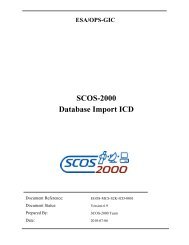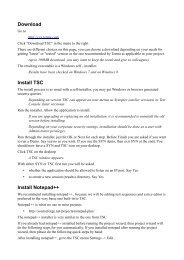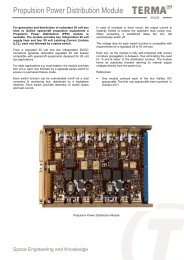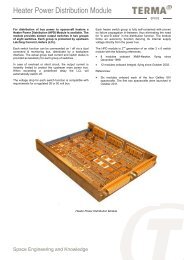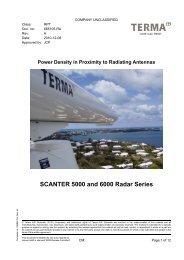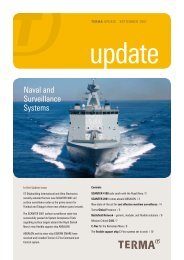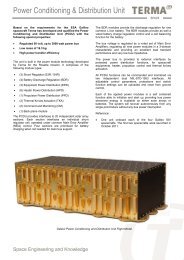Power Density in Proximity to a 2001 Transceiver using any Terma ...
Power Density in Proximity to a 2001 Transceiver using any Terma ...
Power Density in Proximity to a 2001 Transceiver using any Terma ...
Create successful ePaper yourself
Turn your PDF publications into a flip-book with our unique Google optimized e-Paper software.
Class: RPT<br />
Doc. no: 26<strong>2001</strong>-RM<br />
Rev: A<br />
Date: 2007-04-23<br />
Approved by: JCP<br />
<strong>Power</strong> <strong>Density</strong> <strong>in</strong> <strong>Proximity</strong> <strong>to</strong> a <strong>2001</strong> <strong>Transceiver</strong> us<strong>in</strong>g <strong>any</strong><br />
<strong>Terma</strong> SD, HG or LA Antenna<br />
SCANTER <strong>2001</strong><br />
Template no: 199997-FA, Rev. B<br />
© <strong>Terma</strong> A/S, Denmark, 2007. Proprietary and <strong>in</strong>tellectual rights of <strong>Terma</strong> A/S, Denmark are <strong>in</strong>volved <strong>in</strong> the subject-matter of this material and all manufactur<strong>in</strong>g,<br />
reproduction, use, disclosure, and sales rights perta<strong>in</strong><strong>in</strong>g <strong>to</strong> such subject-matter are expressly reserved. This material is submitted for a specific purpose as<br />
agreed <strong>in</strong> writ<strong>in</strong>g, and the recipient by accept<strong>in</strong>g this material agrees that this material will not be used, copied, or reproduced <strong>in</strong> whole or <strong>in</strong> part nor its contents<br />
(or <strong>any</strong> part thereof) revealed <strong>in</strong> <strong>any</strong> manner or <strong>to</strong> <strong>any</strong> third party, except own staff, <strong>to</strong> meet the purpose for which it was submitted and subject <strong>to</strong> the terms of the<br />
written agreement.<br />
. .<br />
This document is released for use only if signed by<br />
relevant staff or stamped “EDM Release Controlled”.<br />
CM:<br />
. . Page 1 of 14
<strong>Power</strong> <strong>Density</strong> <strong>in</strong> <strong>Proximity</strong> <strong>to</strong> a <strong>2001</strong> <strong>Transceiver</strong> us<strong>in</strong>g <strong>any</strong> <strong>Terma</strong> SD, HG or LA Antenna<br />
Doc. no: 26<strong>2001</strong>-RM, Rev: A<br />
Page 2 of 14<br />
Record of Changes<br />
CR/CO Description Rev Date<br />
First release A See first page<br />
The use and/or disclosure, etc. of the contents of this document (or <strong>any</strong> part thereof) is subject <strong>to</strong> the restrictions referenced on the front page.
<strong>Power</strong> <strong>Density</strong> <strong>in</strong> <strong>Proximity</strong> <strong>to</strong> a <strong>2001</strong> <strong>Transceiver</strong> us<strong>in</strong>g <strong>any</strong> <strong>Terma</strong> SD, HG or LA Antenna<br />
Doc. no: 26<strong>2001</strong>-RM, Rev: A<br />
Page 3 of 14<br />
Contents<br />
1 INTRODUCTION ...............................................................................................4<br />
2 REFERENCED DOCUMENTATION..................................................................4<br />
3 THE SCANTER <strong>2001</strong> CONCEPT ......................................................................6<br />
4 POWER DENSITIES .........................................................................................6<br />
5 RESULTS..........................................................................................................7<br />
5.1 <strong>Power</strong> density con<strong>to</strong>urs......................................................................................7<br />
5.2 Additional remarks ...........................................................................................14<br />
The use and/or disclosure, etc. of the contents of this document (or <strong>any</strong> part thereof) is subject <strong>to</strong> the restrictions referenced on the front page.
<strong>Power</strong> <strong>Density</strong> <strong>in</strong> <strong>Proximity</strong> <strong>to</strong> a <strong>2001</strong> <strong>Transceiver</strong> us<strong>in</strong>g <strong>any</strong> <strong>Terma</strong> SD, HG or LA Antenna<br />
Doc. no: 26<strong>2001</strong>-RM, Rev: A<br />
Page 4 of 14<br />
1 INTRODUCTION<br />
<strong>Terma</strong> has <strong>in</strong> resent years been successful <strong>in</strong> the development of novel receiver and<br />
process<strong>in</strong>g technology, reduc<strong>in</strong>g the required transmitter power for a given radar<br />
performance. This does substantially reduce the microwave radiation when compared <strong>to</strong> that<br />
possible just a few years ago. However, there is an <strong>in</strong>creas<strong>in</strong>g concern <strong>in</strong> the public about<br />
radiation from microwave sources. This document was therefore made <strong>to</strong> summarize the<br />
results from an analysis of the <strong>in</strong>cident microwave power levels (safety levels) present <strong>in</strong> the<br />
vic<strong>in</strong>ity of SCANTER <strong>2001</strong> radar systems.<br />
All restricted data has been omitted and the document may therefore be released <strong>to</strong> third<br />
parties on a need <strong>to</strong> know basis (as decided by end users of the radar systems).<br />
Two different safety levels, one for the general public and one for occupational exposure, are<br />
def<strong>in</strong>ed <strong>in</strong> guidel<strong>in</strong>es from the International Commission of Non-Ioniz<strong>in</strong>g Radiation Protection,<br />
ICNIRP [1]. The ICNIRP guidel<strong>in</strong>es have been used throughout the analysis.<br />
The ma<strong>in</strong> conclusions <strong>in</strong> relation <strong>to</strong> SCANTER <strong>2001</strong> radars us<strong>in</strong>g <strong>any</strong> of the <strong>Terma</strong> standard<br />
(SD), high ga<strong>in</strong> (HG) or large aperture (LA) antennas are:<br />
• The ICNIRP recommendations for general public and occupational staff are met for<br />
all locations beyond 12m <strong>in</strong> the horizontal plane from or 1m above/below the<br />
antenna.<br />
• Microwave power is not emitted from <strong>any</strong> parts of the SCANTER <strong>2001</strong> system, but<br />
from the antenna.<br />
The antenna will typically be elevated at least 30 meters above ground levels when the<br />
SCANTER <strong>2001</strong> radar is used for land based applications In such case, the microwave<br />
power exposure at ground level was calculated <strong>to</strong> be a fac<strong>to</strong>r of 100 or more below the<br />
ICNIRP recommendations for general pubic.<br />
An artistic impression of the safety limits is shown on the next page.<br />
2 REFERENCED DOCUMENTATION<br />
[1] International Commission of Non-Ioniz<strong>in</strong>g Radiation Protection. Guidel<strong>in</strong>es for<br />
Limit<strong>in</strong>g Exposure <strong>to</strong> time Vary<strong>in</strong>g Electrical, Magnetic and Electromagnetic Fields<br />
(Up <strong>to</strong> 300 GHz). Health Physics 74, 74(No.4):494-522, April 1988.<br />
The use and/or disclosure, etc. of the contents of this document (or <strong>any</strong> part thereof) is subject <strong>to</strong> the restrictions referenced on the front page.
<strong>Power</strong> <strong>Density</strong> <strong>in</strong> <strong>Proximity</strong> <strong>to</strong> a <strong>2001</strong> <strong>Transceiver</strong> us<strong>in</strong>g <strong>any</strong> <strong>Terma</strong> SD, HG or LA Antenna<br />
Doc. no: 26<strong>2001</strong>-RM, Rev: A<br />
Page 5 of 14<br />
Limit for general public<br />
exposure<br />
Artistic impression of calculated safety region apply<strong>in</strong>g for<br />
<strong>any</strong> <strong>Terma</strong> standard, high ga<strong>in</strong> or large aperture antenna.<br />
30 meter high <strong>to</strong>wer<br />
The use and/or disclosure, etc. of the contents of this document (or <strong>any</strong> part thereof) is subject <strong>to</strong> the restrictions referenced on the front page.
<strong>Power</strong> <strong>Density</strong> <strong>in</strong> <strong>Proximity</strong> <strong>to</strong> a <strong>2001</strong> <strong>Transceiver</strong> us<strong>in</strong>g <strong>any</strong> <strong>Terma</strong> SD, HG or LA Antenna<br />
Doc. no: 26<strong>2001</strong>-RM, Rev: A<br />
Page 6 of 14<br />
3 THE SCANTER <strong>2001</strong> CONCEPT<br />
SCANTER <strong>2001</strong> is a non-coherent radar system provid<strong>in</strong>g Surface Surveillance. Depend<strong>in</strong>g<br />
on the application, the system comprises one or two sets of transmitters and receivers.<br />
Two transmitters, transmitt<strong>in</strong>g on separate frequencies with<strong>in</strong> the 9.14GHz <strong>to</strong> 9.50GHz band<br />
are utilized <strong>in</strong> the majority of applications. This, concept giv<strong>in</strong>g highest transmitted power,<br />
was assumed for the analysis referred by this document.<br />
Energy transmitted can be varied depend<strong>in</strong>g on operational needs. The highest possible<br />
energy has been assumed for the analysis. For the average power analysis 80W is applied.<br />
For the peak power analysis, 30kW is applied.<br />
The analysis is based on antennas of the standard (SD), high ga<strong>in</strong> (HG) and large aperture<br />
(LA) types. All antennas have been analyzed at the 9.305GHz frequency, except for the 15’<br />
LA-HP/CP-C-39 antenna that has been analyzed at 8.893GHz. The results for the 15’ LA-<br />
HP/CP-C-39 antenna are nevertheless representative for an antenna with<strong>in</strong> the 9.14GHz <strong>to</strong><br />
9.50GHz with a similar antenna pattern.<br />
For each of the three antenna types the flow<strong>in</strong>g antenna variants exist:<br />
Standard antennas:<br />
7’ SD-HP-F-31, 12’ SD-HP-33 and 18’ SD-HP-F-35.<br />
High ga<strong>in</strong> antennas:<br />
18’ HG-HP/CP-F-37, 18’ HG-HP/CP-C/I-36, 21' HG-HP/CP-F-38 and 21’ HG-HP/CP-C/I-37.<br />
Large aperture antennas:<br />
15’ LA-HP/CP-C-39 and 21’ LA-HP/CP-F-42.<br />
The generation of microwave energy and its transmission <strong>to</strong> the antenna is conf<strong>in</strong>ed with<strong>in</strong><br />
an unbroken metal enclosure. Therefore, microwave power is not emitted from <strong>any</strong> parts of<br />
the SCANTER <strong>2001</strong> radar system, but from the antennas.<br />
Transmitters are closed down when the antenna rotation is s<strong>to</strong>pped.<br />
4 POWER DENSITIES<br />
Measurement of radiation levels from radar systems is a specialized task and radiation levels<br />
are therefore often determ<strong>in</strong>ed by assum<strong>in</strong>g the radar <strong>to</strong> ma<strong>in</strong>ta<strong>in</strong> its far-field antenna ga<strong>in</strong> at<br />
all distances for energy and determ<strong>in</strong><strong>in</strong>g distant power levels by a simple equation. However,<br />
with the large aperture antennas used <strong>in</strong> the SCANTER radar systems, results from this<br />
method may be mislead<strong>in</strong>g.<br />
The difference between the simple radar equation and the formulation used by <strong>Terma</strong> is a<br />
number of extensions that allow for model<strong>in</strong>g of the exact location, the orientation and the<br />
type of the transmitt<strong>in</strong>g antenna(s). In particular, the formulation allows for careful model<strong>in</strong>g<br />
of the near-field characteristics of a radiat<strong>in</strong>g antenna. These near-field characteristics are<br />
important as the spread<strong>in</strong>g of the microwave power <strong>in</strong> the vic<strong>in</strong>ity of the antenna is quite<br />
different from the characteristics at large distances from the antenna (<strong>in</strong> the far-field). Failure<br />
<strong>to</strong> <strong>in</strong>clude the near-field characteristics may lead <strong>to</strong> over-estimated power densities with<strong>in</strong> the<br />
antenna ma<strong>in</strong> beam and <strong>to</strong> underestimated <strong>in</strong>cident power densities outside the antenna<br />
ma<strong>in</strong> beam.<br />
The use and/or disclosure, etc. of the contents of this document (or <strong>any</strong> part thereof) is subject <strong>to</strong> the restrictions referenced on the front page.
<strong>Power</strong> <strong>Density</strong> <strong>in</strong> <strong>Proximity</strong> <strong>to</strong> a <strong>2001</strong> <strong>Transceiver</strong> us<strong>in</strong>g <strong>any</strong> <strong>Terma</strong> SD, HG or LA Antenna<br />
Doc. no: 26<strong>2001</strong>-RM, Rev: A<br />
Page 7 of 14<br />
In addition, the surround<strong>in</strong>gs, which may cause so-called multi-path propagation, must be<br />
considered. Reference levels stated by the ICNIRP guidel<strong>in</strong>es <strong>in</strong>clude these necessary<br />
safety fac<strong>to</strong>rs <strong>to</strong> allow for such effects.<br />
The amount of <strong>in</strong>cident power <strong>in</strong> <strong>any</strong> position <strong>in</strong> the surround<strong>in</strong>gs of the microwave source is<br />
measured <strong>in</strong> Watts per m 2 .<br />
Accord<strong>in</strong>g <strong>to</strong> the ICNIRP guidel<strong>in</strong>e, the limit for the <strong>in</strong>cident power density level for the<br />
general public is 10W/m 2 <strong>in</strong> the frequency band from 2-300GHz and over <strong>any</strong> 6 m<strong>in</strong>ute<br />
period. The SCANTER <strong>2001</strong> radars operate with<strong>in</strong> this frequency range.<br />
The correspond<strong>in</strong>g level for occupational exposure is 50 W/m 2 .<br />
Furthermore, the ICNIRP guidel<strong>in</strong>es states that the peak power density shall not exceed the<br />
average power density by a fac<strong>to</strong>r of more than 1000.<br />
5 RESULTS<br />
5.1 <strong>Power</strong> density con<strong>to</strong>urs<br />
The analysis of <strong>in</strong>cident power density is based on a formulation similar <strong>to</strong> the radar<br />
equation. Each antenna is described <strong>in</strong> terms of its aperture distribution, which allow for<br />
computation of its near-field characteristics.<br />
Average as well as peak power results are presented. The worst of the two are been used for<br />
determ<strong>in</strong><strong>in</strong>g the safety distance required <strong>to</strong> comply with the ICNIRP recommendations.<br />
Allowance for production <strong>to</strong>lerances has been made.<br />
In Figure 1 through Figure 3 the results correspond<strong>in</strong>g <strong>to</strong> the peak power limit, i.e. the<br />
10kW/m 2 limit as recommended by ICNIRP for the general public, are shown for each of the<br />
three groups, i.e. standard (SD), high ga<strong>in</strong> (HG) and large aperture (LA) antennas. As the<br />
antenna rotation dur<strong>in</strong>g the short time allowed for the radar pulse is extremely limited, the<br />
antenna is assumed non-rotat<strong>in</strong>g.<br />
In Figure 4 through Figure 6 the results correspond<strong>in</strong>g <strong>to</strong> the average power limit for rotat<strong>in</strong>g<br />
antennas, i.e. the 10W/m 2 limit as recommended by ICNIRP for the general public, are<br />
shown for each of the three groups, i.e. standard (SD), high ga<strong>in</strong> (HG) and large aperture<br />
(LA) antennas.<br />
The use and/or disclosure, etc. of the contents of this document (or <strong>any</strong> part thereof) is subject <strong>to</strong> the restrictions referenced on the front page.
<strong>Power</strong> <strong>Density</strong> <strong>in</strong> <strong>Proximity</strong> <strong>to</strong> a <strong>2001</strong> <strong>Transceiver</strong> us<strong>in</strong>g <strong>any</strong> <strong>Terma</strong> SD, HG or LA Antenna<br />
Doc. no: 26<strong>2001</strong>-RM, Rev: A<br />
Page 8 of 14<br />
5.1.1 Peak power limitations<br />
7’ SD-HP-F-31<br />
12’ SD-HP-F-33<br />
18’ SD-HP-F-35<br />
Figure 1 Safety distances for standard antennas, 30kW peak power<br />
The use and/or disclosure, etc. of the contents of this document (or <strong>any</strong> part thereof) is subject <strong>to</strong> the restrictions referenced on the front page.
<strong>Power</strong> <strong>Density</strong> <strong>in</strong> <strong>Proximity</strong> <strong>to</strong> a <strong>2001</strong> <strong>Transceiver</strong> us<strong>in</strong>g <strong>any</strong> <strong>Terma</strong> SD, HG or LA Antenna<br />
Doc. no: 26<strong>2001</strong>-RM, Rev: A<br />
Page 9 of 14<br />
18’ HG-HP/CP-F-37<br />
18’ HG-HP/CP-I-36<br />
18’ HG-HP/CP-C-36<br />
21' HG-HP/CP-F-38<br />
21’ HG-HP/CP-I-37<br />
21’ HG-HP/CP-C-37<br />
Figure 2 Safety distances for high ga<strong>in</strong> antennas, 30kW peak power<br />
The use and/or disclosure, etc. of the contents of this document (or <strong>any</strong> part thereof) is subject <strong>to</strong> the restrictions referenced on the front page.
<strong>Power</strong> <strong>Density</strong> <strong>in</strong> <strong>Proximity</strong> <strong>to</strong> a <strong>2001</strong> <strong>Transceiver</strong> us<strong>in</strong>g <strong>any</strong> <strong>Terma</strong> SD, HG or LA Antenna<br />
Doc. no: 26<strong>2001</strong>-RM, Rev: A<br />
Page 10 of 14<br />
15’ LA-HP/CP-C-39<br />
21’ LA-HP/CP-F-42<br />
Figure 3 Safety distances for high ga<strong>in</strong> antennas, 30kW peak power<br />
The use and/or disclosure, etc. of the contents of this document (or <strong>any</strong> part thereof) is subject <strong>to</strong> the restrictions referenced on the front page.
<strong>Power</strong> <strong>Density</strong> <strong>in</strong> <strong>Proximity</strong> <strong>to</strong> a <strong>2001</strong> <strong>Transceiver</strong> us<strong>in</strong>g <strong>any</strong> <strong>Terma</strong> SD, HG or LA Antenna<br />
Doc. no: 26<strong>2001</strong>-RM, Rev: A<br />
Page 11 of 14<br />
5.1.2 Average power limitations<br />
7’ SD-HP-F-31<br />
12’ SD-HP-F-33<br />
18’ SD-HP-F-35<br />
Figure 4 Safety distances for standard antennas, 80W average power<br />
The use and/or disclosure, etc. of the contents of this document (or <strong>any</strong> part thereof) is subject <strong>to</strong> the restrictions referenced on the front page.
<strong>Power</strong> <strong>Density</strong> <strong>in</strong> <strong>Proximity</strong> <strong>to</strong> a <strong>2001</strong> <strong>Transceiver</strong> us<strong>in</strong>g <strong>any</strong> <strong>Terma</strong> SD, HG or LA Antenna<br />
Doc. no: 26<strong>2001</strong>-RM, Rev: A<br />
Page 12 of 14<br />
18’ HG-HP/CP-F-37<br />
18’ HG-HP/CP-I-36<br />
18’ HG-HP/CP-C-36<br />
21' HG-HP/CP-F-38<br />
21’ HG-HP/CP-I-37<br />
21’ HG-HP/CP-C-37<br />
Figure 5 Safety distances for high ga<strong>in</strong> antennas, 80W average power<br />
The use and/or disclosure, etc. of the contents of this document (or <strong>any</strong> part thereof) is subject <strong>to</strong> the restrictions referenced on the front page.
<strong>Power</strong> <strong>Density</strong> <strong>in</strong> <strong>Proximity</strong> <strong>to</strong> a <strong>2001</strong> <strong>Transceiver</strong> us<strong>in</strong>g <strong>any</strong> <strong>Terma</strong> SD, HG or LA Antenna<br />
Doc. no: 26<strong>2001</strong>-RM, Rev: A<br />
Page 13 of 14<br />
15’ LA-HP/CP-C-39<br />
21’ LA-HP/CP-F-42<br />
Figure 6 Safety distances for large aperture antennas, 80W average power<br />
The use and/or disclosure, etc. of the contents of this document (or <strong>any</strong> part thereof) is subject <strong>to</strong> the restrictions referenced on the front page.
<strong>Power</strong> <strong>Density</strong> <strong>in</strong> <strong>Proximity</strong> <strong>to</strong> a <strong>2001</strong> <strong>Transceiver</strong> us<strong>in</strong>g <strong>any</strong> <strong>Terma</strong> SD, HG or LA Antenna<br />
Doc. no: 26<strong>2001</strong>-RM, Rev: A<br />
Page 14 of 14<br />
5.2 Additional remarks<br />
Additional safety marg<strong>in</strong>s <strong>in</strong> respect <strong>to</strong> microwave radiation can be obta<strong>in</strong>ed by <strong>in</strong>creas<strong>in</strong>g<br />
distances <strong>to</strong> the radiat<strong>in</strong>g antennas.<br />
As a rule of thumb, the power density is <strong>in</strong>versely proportional <strong>to</strong> the square of the distance<br />
from the radiat<strong>in</strong>g source. Thus, <strong>in</strong>creas<strong>in</strong>g the distance with a fac<strong>to</strong>r of 10 will reduce the<br />
power density with a fac<strong>to</strong>r of 100.<br />
However, this is only true <strong>in</strong> the far fields distance. Complex calculations for the region near<br />
the antennas show that:<br />
• <strong>Power</strong> density is a fac<strong>to</strong>r of at least 10 times below the ICNIRP recommendations<br />
for general public for all locations 5 meter or further below the antenna and at <strong>any</strong><br />
position beyond 90 meter horizontal distance.<br />
• <strong>Power</strong> density is a fac<strong>to</strong>r of at least 100 times below the ICNIRP recommendations<br />
for general public for all locations 30 meters or further below the antenna.<br />
Furthermore, sec<strong>to</strong>r transmission is normally implemented, s<strong>to</strong>pp<strong>in</strong>g transmission for the<br />
parts of the antenna rotation not cover<strong>in</strong>g the sea surface.<br />
For additional safety, SCANTER <strong>2001</strong> transmitters are closed down when antenna rotation is<br />
s<strong>to</strong>pped. However, transmission <strong>in</strong><strong>to</strong> a s<strong>to</strong>pped antenna can be <strong>to</strong>lerated without violat<strong>in</strong>g the<br />
ICNIRP recommendations for general public, for all locations 1.5 meter or further below the<br />
antenna or at <strong>any</strong> position beyond 25 meters horizontal distance.<br />
F<strong>in</strong>ally, for occupational staff, be aware of safety regulations for rotat<strong>in</strong>g mach<strong>in</strong>ery.<br />
The use and/or disclosure, etc. of the contents of this document (or <strong>any</strong> part thereof) is subject <strong>to</strong> the restrictions referenced on the front page.






